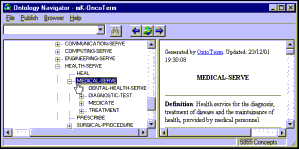
| ISSN: 1139-8736 Depósito Legal: B-37271-2002 Copyright: © Silvia Montero Martínez |
5.3.2.4 HAVE-NEOPLASM_THEME-OF_MEDICAL-SERVE
La relación THEME-OF es la inversa de THEME, unas relaciones no específicas del evento médico que aparecían en la ontología original de MikroKosmos con la siguiente definición:

Figura 5.14: La relación THEME
En cuanto al concepto MEDICAL-SERVE, como se puede apreciar en la siguiente figura se trata de un HEALTH-SERVE que a su vez es un SOCIAL-EVENT. Su modelado en la ontología es el siguiente:

Figura 5.15: El evento MEDICAL-SERVE
El esquema frasémico en este caso incluirá ejemplos como:
|
HAVE-NEOPLASM
|
THEME-OF
(INVERSE-EVENT-STATE-RELATION: INVERSE-CASE-ROLE) |
MEDICAL-SERVE
|
|
|
|
|
|
_TREATMENT
|
||
|
CANCER TUMOR MASS |
400 cancer can be controlled 2 151 to resect residual masses 2 |
|
|
_DIAGNOSTIC-TEST
|
||
|
CANCER |
573 cancer diagnoses 2 1045 diagnosis of breast cancer 2 3831 tumor diagnosis 8 2386 to diagnose tumors 2 |
|
|
_FIND
|
||
|
CANCER TUMOR MASS |
571 cancer detection 3 detecting renal masses 3 |
|
|
_ANALYZE
|
||
|
CANCER |
146 analysis of colon cancer 2 | |
|
_IDENTIFY
|
||
|
TUMOR MALIGNANCY NEOPLASM RETINOBLASTOMA |
128 identifying undifferentiated tumors 2 29 identification of a primary malignancy 3 226 neoplasm classification 3 classification for retinoblastoma 3 |
|
|
_EVALUATE
|
||
|
TUMOR |
46 evaluating an occult primary
tumor 2 187 evaluation of poorly differentiated tumors 3 40 tumor assessment 4 29 assessment of the primary tumor 3 32 evaluating nodal disease 2 |
|
Tabla 5.15: HAVE-NEOPLASM_THEME-OF_MEDICAL-SERVE
Como se puede observar en la tabla 5.15, como subordinado de MEDICAL-SERVE aparece TREATMENT. En este caso hemos incluido FT tales como 'cancer can be controlled' o 'manage liver metastases', en los que 'control' y 'manage', a pesar de su carácter general, adquieren un valor especializado al hacer referencia a TREATMENT gracias a su coaparición con 'cancer' y 'liver metastases', respectivamente. Aparecen también términos hipónimos de TREATMENT tales como 'palliate' o 'resect' en unidades como 'cancer may be palliated' y 'to resect residual masses'. Como ya apuntamos, éstos casos también se podrían haber englobado bajo el esquema HN_TREATED-WITH_TREATMENT.
Por otro lado, DIAGNOSTIC-TEST, hijo de MEDICAL-SERVE se define como:
MEDICAL-SERVE-EVENT carried out by a PHYSICIAN in a HEALTH-CARE-ORGANIZATION to identify and classify a DISEASE-EVENT with the use of DIAGNOSTIC-DEVICEs.
Bajo su esquema se han incluido casos como 'tumor diagnosis' o 'to diagnose tumors'. Pero como se puede observar, en el corpus se han encontrado FT que contienen hiperónimos del término 'diagnose' tales como 'detection' en 'cancer detection', 'localization' en 'tumor localization', 'analysis' en 'analysis of colon cancer', 'classify' en 'to classify a tumor', 'identify' en 'to identify the disease', etc. De nuevo observamos la coaparición de unidades pertenecientes al lexicón primario que adquieren un significado especializado por su formalización en FT.
Para finalizar, las estructuras sintácticas de estos FT responden a los siguientes patrones:
(109)
a. MEDICAL-SERVE HAVE-NEOPLASM ![]() 'remove the primary tumor', 'to diagnose tumors', 'evaluating an occult primary
tumor'
'remove the primary tumor', 'to diagnose tumors', 'evaluating an occult primary
tumor'
b. HAVE-NEOPLASM MEDICAL-SERVE ![]() 'cancer diagnoses', 'neoplasm classification'
'cancer diagnoses', 'neoplasm classification'
c. MEDICAL-SERVE of HAVE-NEOPLASM ![]() 'diagnosis of breast cancer', 'detection of prostate cancer'
'diagnosis of breast cancer', 'detection of prostate cancer'
d. MEDICAL-SERVE for HAVE-NEOPLASM ![]() 'classification
for retinoblastoma'
'classification
for retinoblastoma'
Índice general I Índice Capítulo 5 I Siguiente
| ISSN: 1139-8736 Depósito Legal: B-37271-2002 Copyright: © Silvia Montero Martínez |